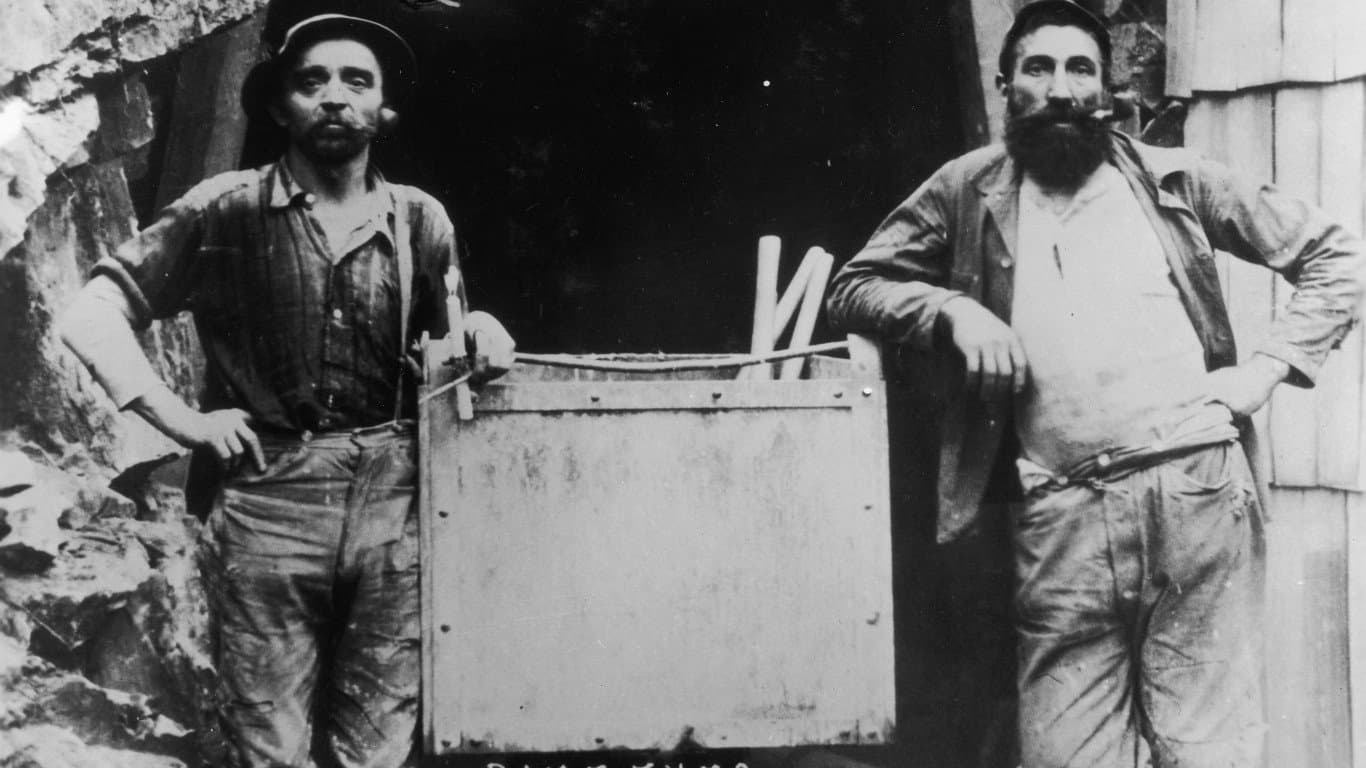Like the speed of a camera lens, life seems to change rapidly, with each new era bringing change. New methods, techniques, and inventions are always evolving, ways to potentially make our lives better, easier, and more comfortable. Ways that increase our productivity, allowing us to work faster and smarter, not harder. Life in America wasn’t always like this, even just a few decades ago.
America today vastly differs from 10 years ago, even from last year, and most certainly centuries ago. Everywhere you look you can see change, from our technology and infrastructure, to our utilities and much, much more. Many of us often wonder what life was like in the past, when such conveniences weren’t available. It is easier to see back to the early part of our century, and even the previous century, but we may often wonder what life was like even further back, in the 19th century.
Thanks to written accounts from both historians of the period, and various diaries and manuscripts that show firsthand accounts, we are made aware of the numerous harsh living conditions, and the struggles of extremely long work hours. Most people didn’t have running water, heat, or electricity, and used candles well in the early 20th century. Fortunately, early photographers have documented this history, allowing us to see mid-19th century America for ourselves. (Several written accounts can be found at The Library of Congress.)
One of the most substantial changes throughout the years is to photography, which was invented in 1822 by Frenchman Joseph Nicéphore Niépce. His images required days of exposure in the camera and while the first examples of his work are no longer around, the oldest surviving photograph created with a camera dates to around 1826, taken by Niépce. But it was Niépce’s associate Louis Daguerre who went on to develop the daguerreotype process, the first commercially viable photographic process that required only minutes of exposure.
Various archives, both public and private, have ample collections of the results. Using photos from Getty Images, 24/7 Tempo has assembled a portfolio of photos documenting various aspects of the American scene between 1870 and 1898. It should be noted that many dates are approximate, but in many cases are estimated according to evidence revealed in the images themselves. (To see what our medical facilities were like, see what a hospital looked like 100 years ago).
Here are iconic images of late 19th-century American life:
1870: Mining Town Virginia City, Nevada
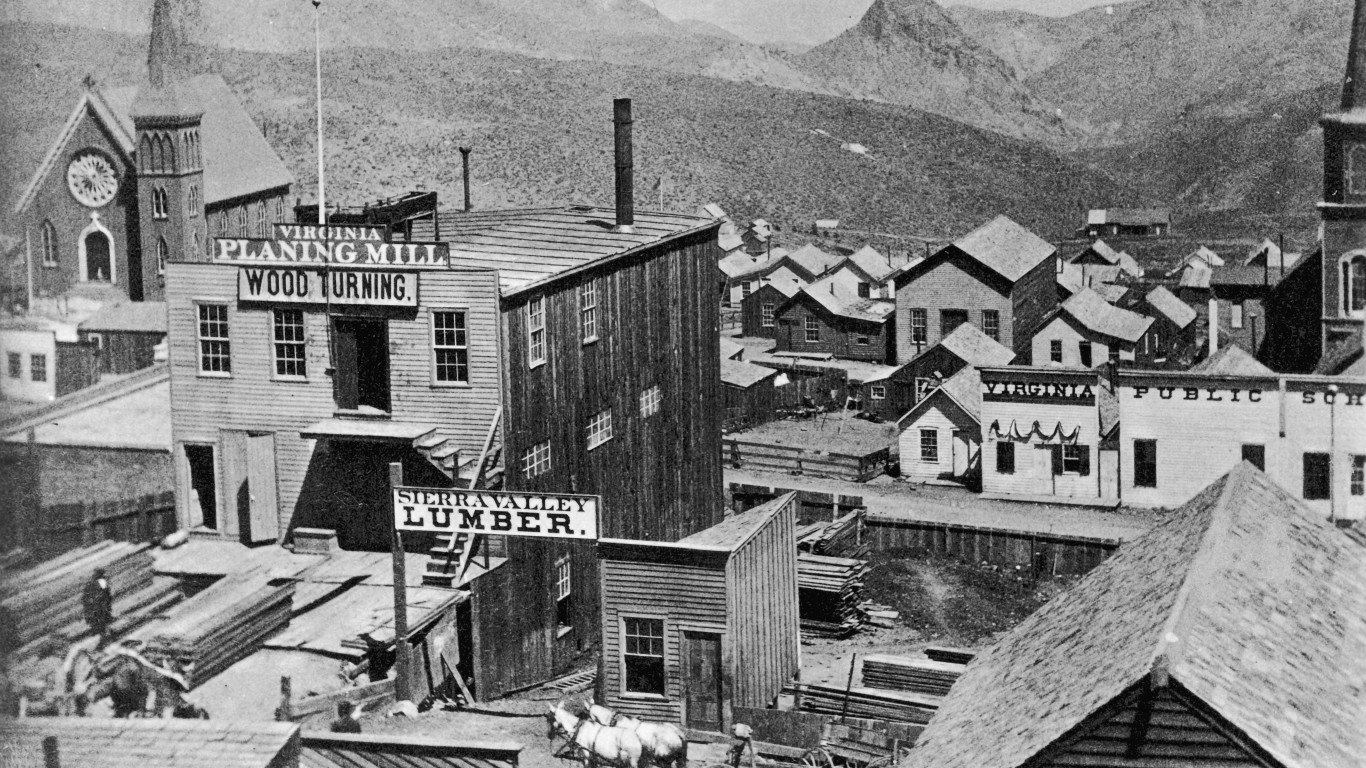
Virginia City was once part of the Utah Territory but became part of Nevada after the Nevada Territory was established by Congress in 1861. When a rich deposit of silver, known as the Comstock Lode, was discovered on nearby Mount Davidson, it became a boomtown.
By the mid-1870s, the town had a population of about 25,000, a thriving lumber industry, multiple churches, and hundreds of saloons. This image shows the Virginia Planning Mill and Sierra Valley Lumber. By the late 1870s, the silver began to run out, and the population declined; today the town has about 855 inhabitants.
1871: Photographer William Henry Jackson on Mount Washburn
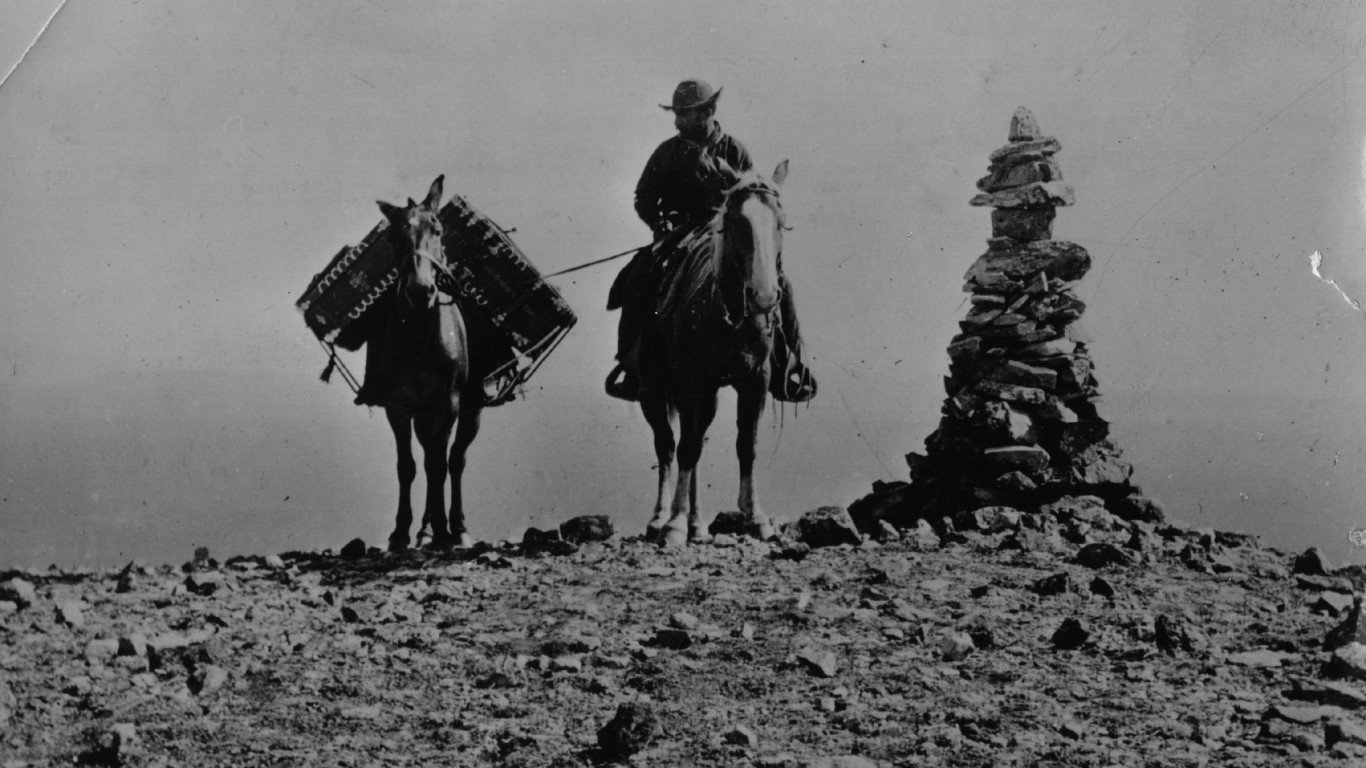
Noted geological photographer William Henry Jackson is shown in the image carrying his photographic equipment on horseback over the summit of Mount Washburn, a prominent peak in what was about to become the nation’s first national park, Yellowstone National Park, established by President Ulysses S. Grant in March 1872.
Jackson was hired by the U.S. Government to document the expedition into Yellowstone. It was during this 1871 geological survey that many images, like the one above, were captured of the soon-to-be park.
1871: A Pawnee Tribe family in Loup, Nebraska
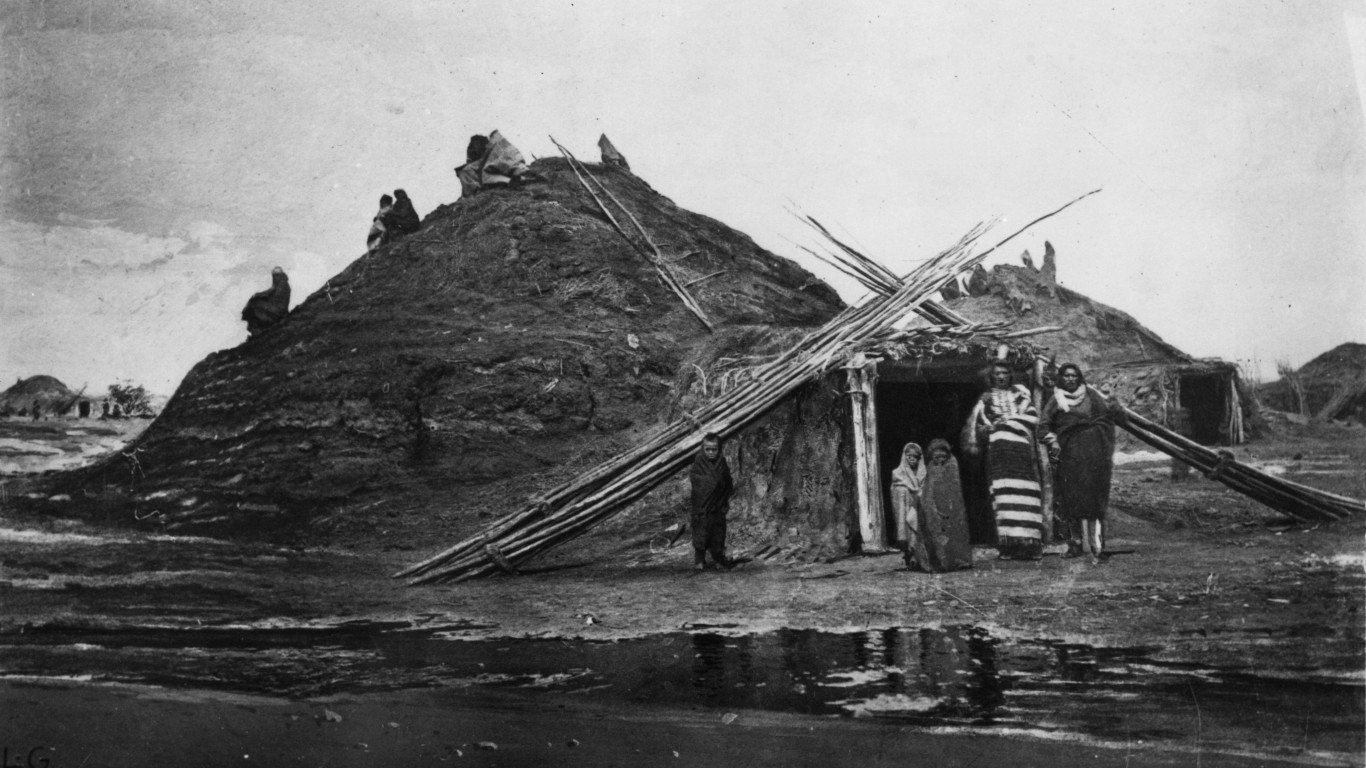
Famed Wild West photographer William Henry Jackson, whose images chronicled many aspects of American life and the country’s landscape, captured this image of a Pawnee Indian family outside their earth lodge in Loup County, Nebraska.
This tribe was named for a tribal band known as the Wolf Pawnee (Loup Pawnee in French). The Pawnee people are a Central Plains tribe who were mostly nomadic and once based in Kansas and Nebraska, relocated to Indian Territory, in what is now Oklahoma, in 1875.
1872: The Colorado Valley, Texas

The first official U.S. government expedition through the Grand Canyon occurred in 1869, with another in 1871 and 1872. Several exploratory missions along the course of the Colorado River in the American Southwest were led by geologist John Wesley Powell. This image from the 1871 trip was taken by photographer E.O. Beaman, although its exact location along the river is unknown.
1876: An aerial view of Omaha, Nebraska

On March 1, 1867, Nebraska was admitted to the union as the 37th state. By the early 20th century, Omaha was home to four of the country’s five major pork processing plants but at the time of this image, it had only just begun to thrive when the westward construction of the transcontinental railroad began in the city in 1866. This aerial view was taken from the tower of Omaha High School.
1876: New York City Skyline seen from the Brooklyn Bridge
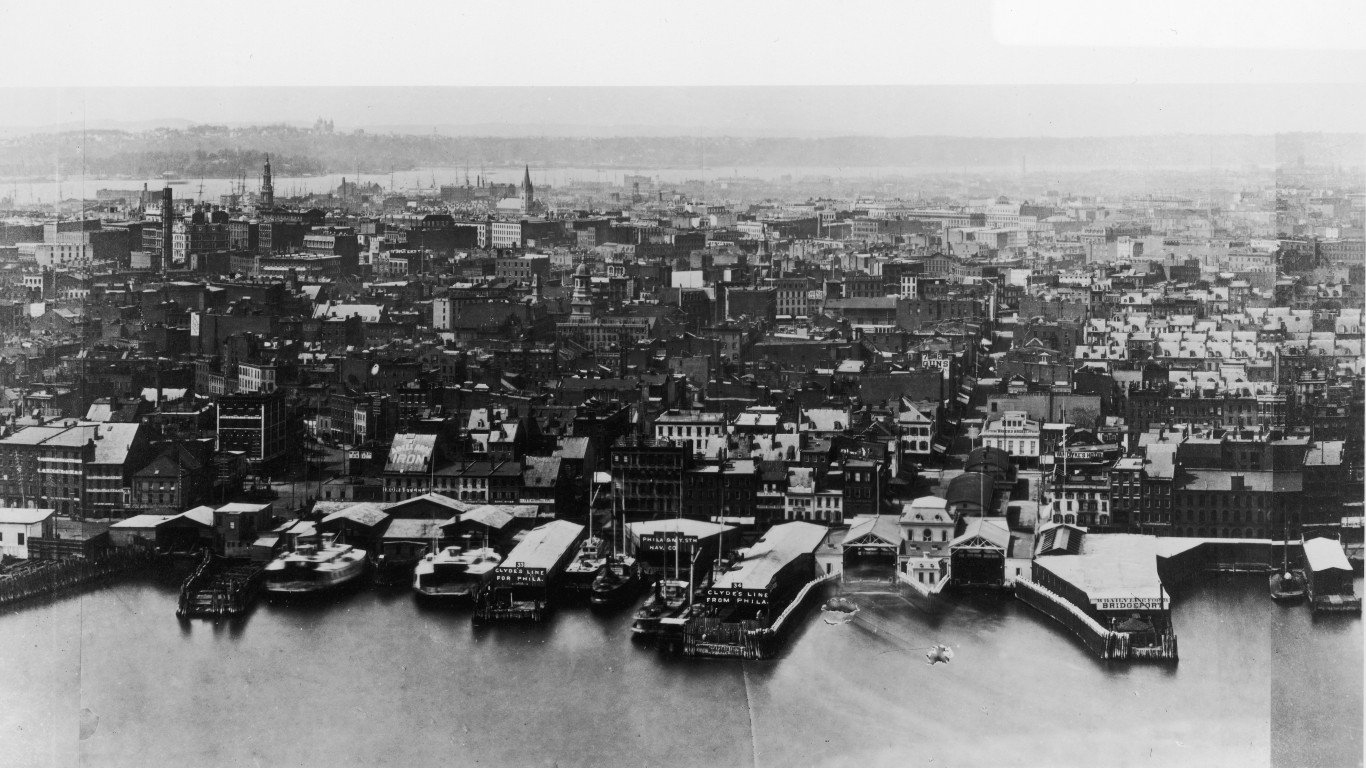
The Brooklyn Bridge was originally known by many names – the East River Bridge, the New York and Brooklyn Bridge, the Great East River Bridge, or simply “The Bridge.” It wasn’t until after Brooklyn became part of New York City that its name changed to its current moniker.
Manhattan already had a population of almost a million people when this panoramic view of the city was taken from the Brooklyn Tower on the eastern end of the Brooklyn Bridge. The suspension cables hadn’t been installed on the bridge yet, which didn’t open officially until 1883.
1877: A street in Deadwood, South Dakota
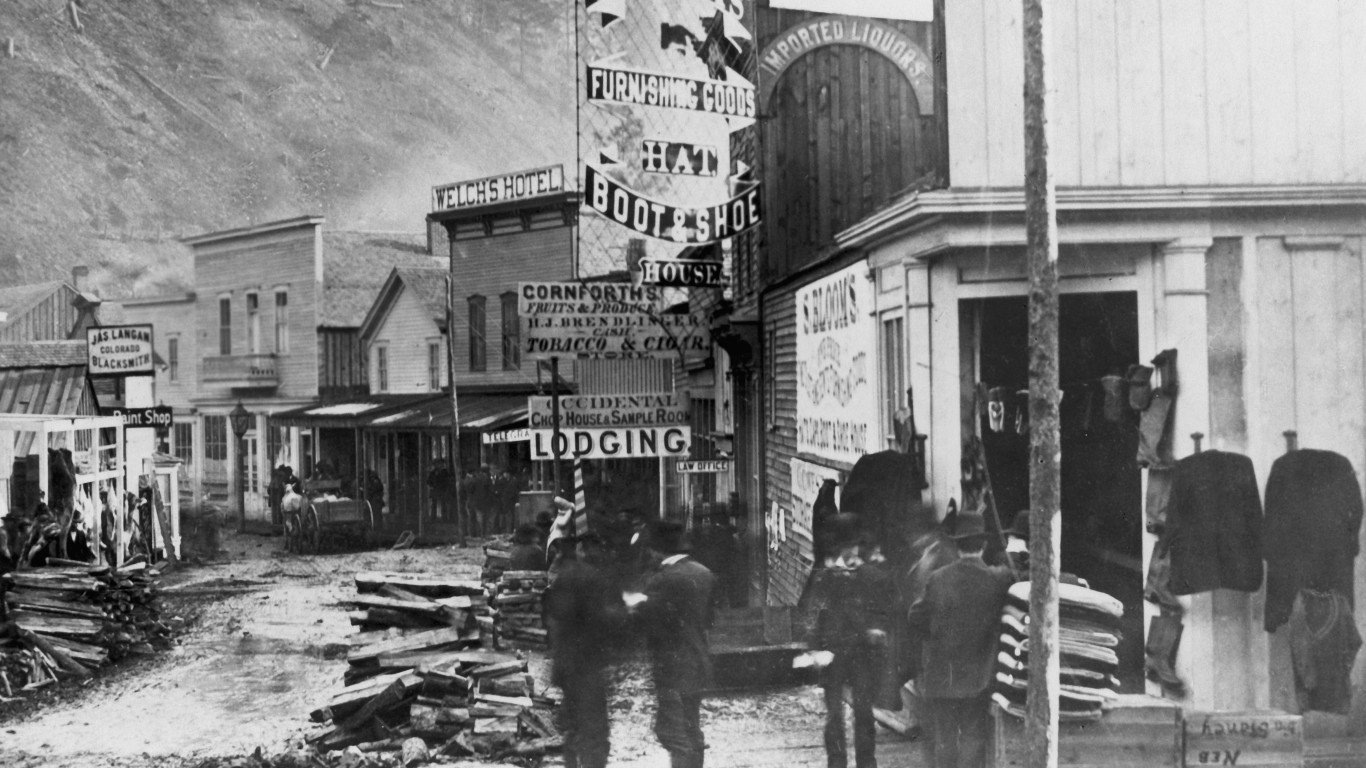
Frank Jay Haynes, who was the official photographer for both Yellowstone National Park and the Northern Pacific Railroad, maintained studios in Minnesota and North Dakota and had another one in a Northern Pacific railroad car, which covered much of the Northwest. The Black Hills Gold Rush had turned Deadwood into a boom town by the time this photo was taken. Once home to such Old West legends as Calamity Jane, Wyatt Earp, and Wild Bill Hickok, the town, in a fictionalized version, was the setting for the HBO series “Deadwood.”
1880: Looking south along Fifth Avenue, New York City
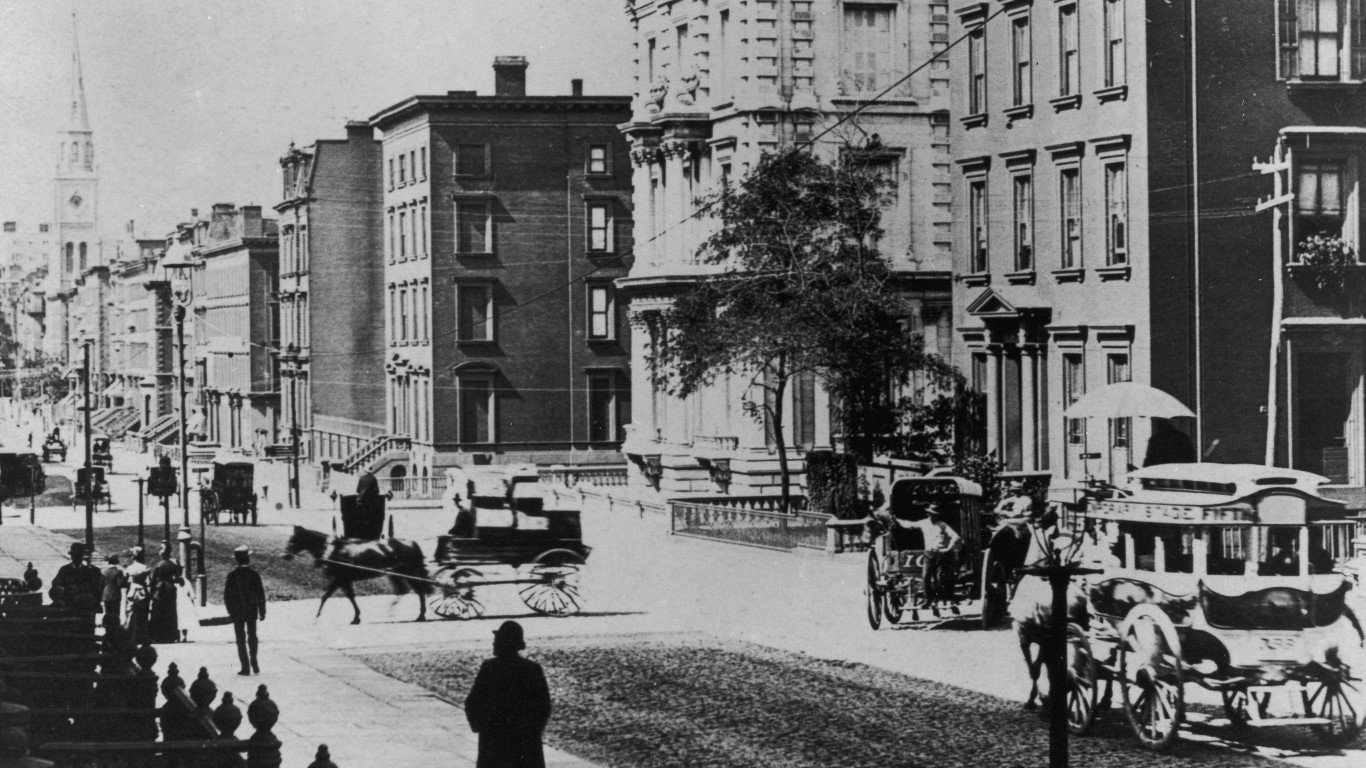
More than a million people crowded the streets of Manhattan when this picture was taken, looking south along Fifth Avenue from 35th Street. The fabled A.T. Stewart mansion, the large building second from the right was at the corner of Fifth and 34th. Stewart was an Irish immigrant who turned a dry goods shop into a multimillion-dollar international business, becoming one of America’s richest men and known as the “Merchant Prince of America”.
In 1865, he announced plans to demolish the existing mansion, and by 1869, the home was completed, becoming one of the city’s most spectacular private houses, a four-story white marble structure that was said to have cost $2 million (more than $50 million today). Stewart died in 1876, but his widow, Cornelia, would have been living here when this photo was taken. She died in 1886, and in 1901 the mansion was demolished.
1880: Gathering on the lawn in Central Park, New York City

Famed landscape architects Frederick Law Olmsted and Calvert Vaux designed this landmark public park in 1857, and although the park opened to the public the following year, it would take another 18 years for the park to be completed. It became increasingly popular with the general public but the city government neglected its upkeep, and it began to decline by the early 20th century.
It was in 1934 when then-Mayor Fiorello LaGuardia appointed Robert Moses commissioner of the New York City Parks Department that Central Park was restored. It has been further aided by the Central Park Conservancy, created in the late 1980s.
1882: Gold miners in Placer County, California

Placer County’s mining history began with the discovery of gold in 1858, and it became known for its placer deposits, accumulations of gravel or sand containing gold or other valuable minerals. The county takes its name from these placer deposits, and this region west of Lake Tahoe was a major placer mining area.
The Last Chance district is said to have been named by a starving miner who used his last bullet to kill a deer to eat. These two Last Chance miners are wearing Levi jeans from San Francisco, first sold in the 1870s.
1884: A view of Devil’s Gate High Bridge in Colorado
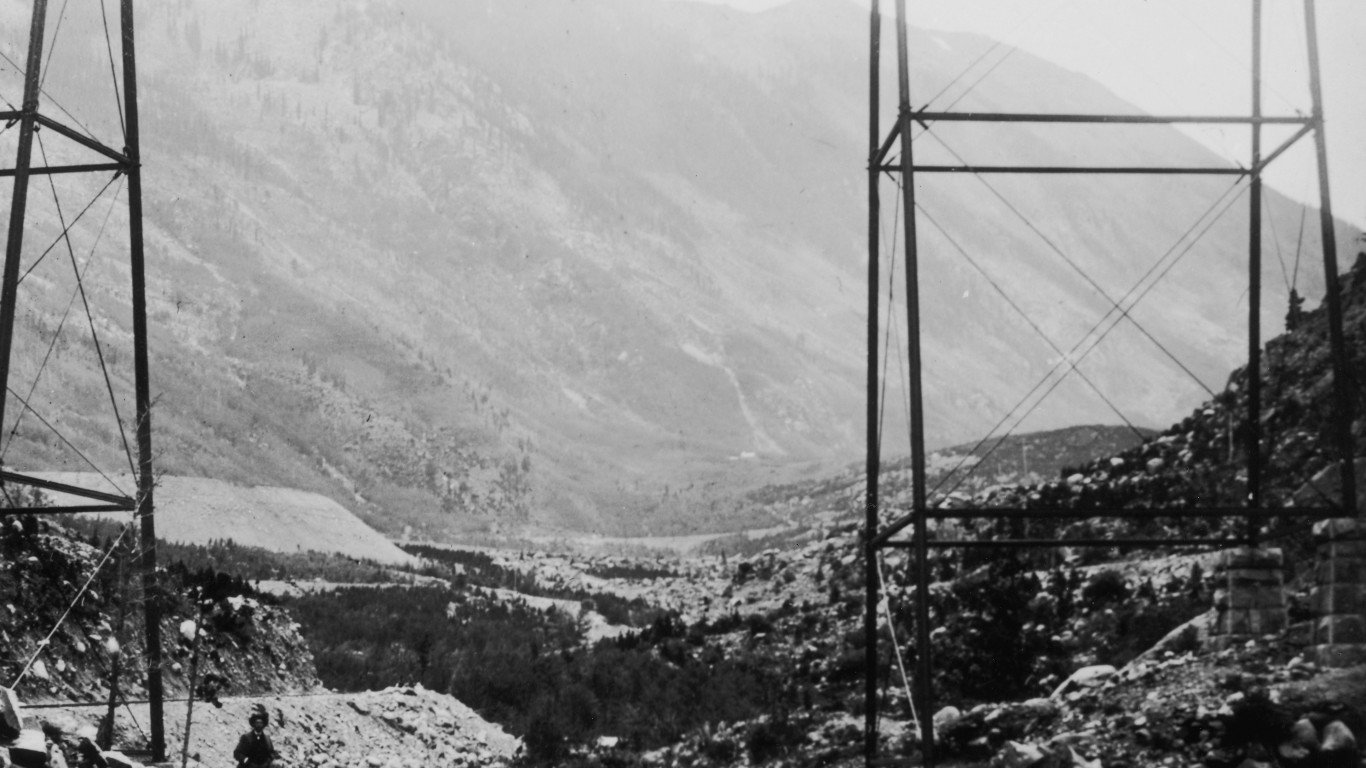
Built in 1884 over the Clear Creek gorge, west of Denver, the Devil’s Gate High Bridge was one of four bridges constructed for the narrow-gauge Georgetown Loop Railroad, which ran between mining towns in the Rocky Mountains. The bridges were considered a remarkable feat of engineering when they were built. Although the line was dismantled in 1939, it was later restored as a tourist attraction.
1886: A pioneer family on the Great Plains
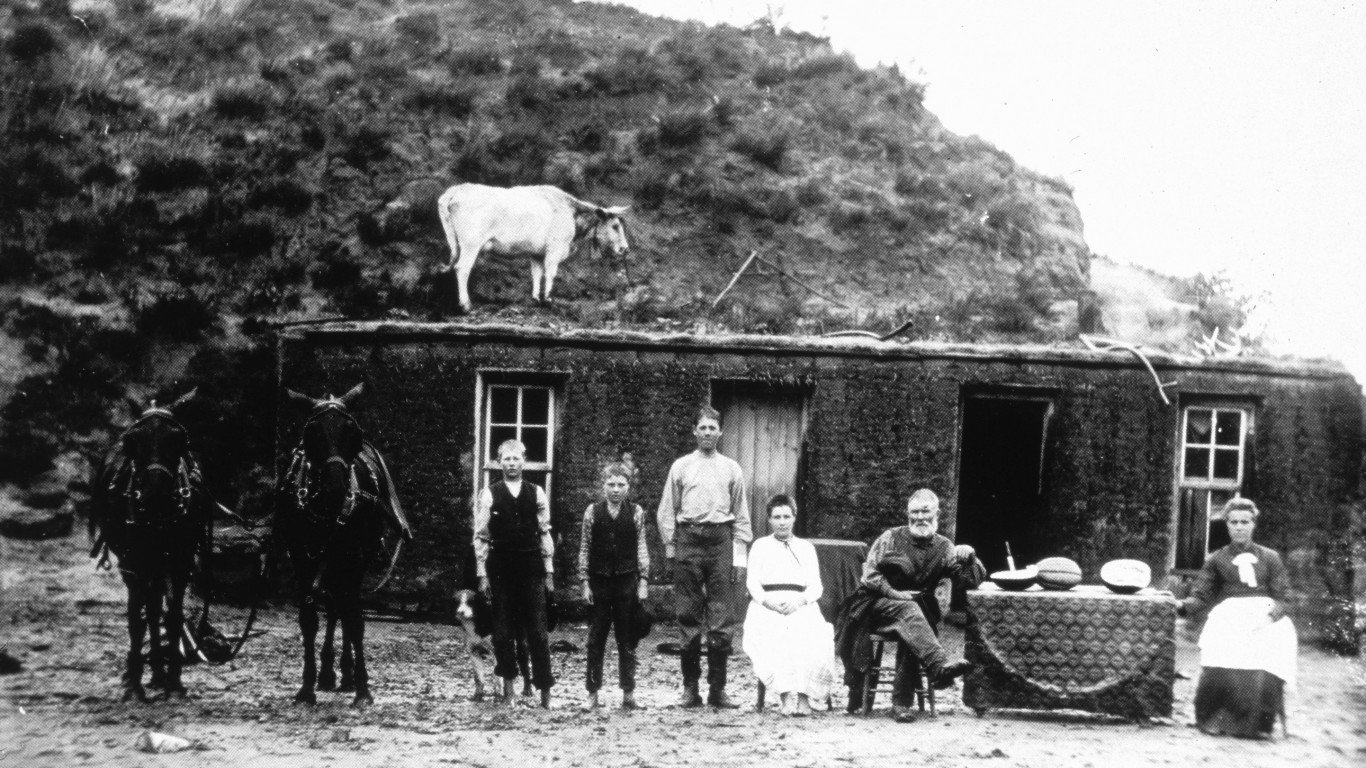
To make up for a lack of trees on the Great Plains, homesteaders often built houses like this one from sod, hardened earth bound together by the root systems of grasses. It appears that a cow is standing on the roof, it’s actually on the hillside just behind the house.
The photo was taken by Solomon D. Butcher, a failed homesteader whose images documented the pioneers in the region, like the Sylvester Rawding family pictured here, north of Sargent in Custer County, Nebraska.
1886: Delegates to the Knights of Labor convention
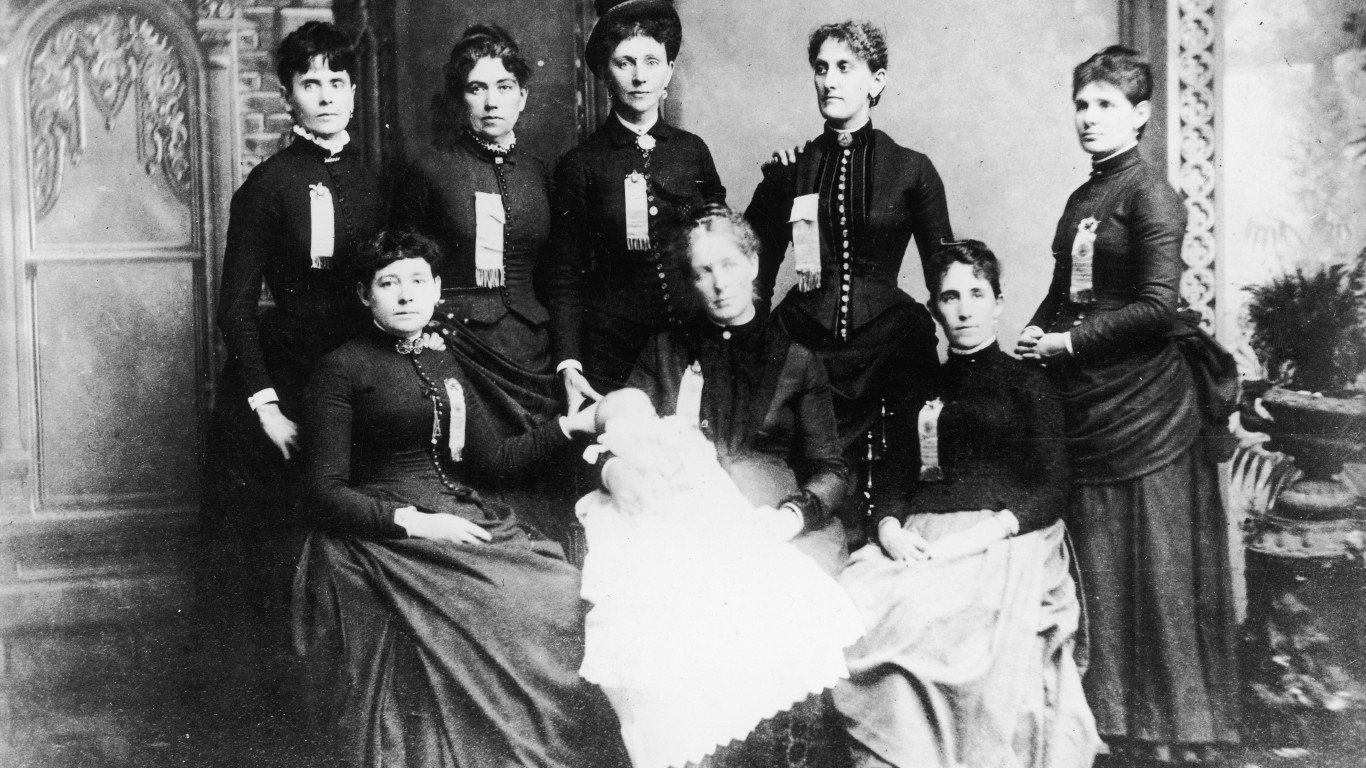
The Noble and Holy Order of the Knights of Labor, known as the Knights of Labor, was one of the most important 19th-century American labor organizations. Founded by Uriah Smith Stephens and eight other Philadelphia tailors in 1869, the Knights proposed a platform that called for an end to child and convict labor, equal pay for women, a progressive income tax, and the cooperative employer-employee ownership of mines and factories.
This image shows eight women delegates (and one baby) to the 1886 convention of the Knights of Labor
1886: A view of the state capitol building, Montgomery, Alabama

In this image is the historic capitol building, completed in 1851, and the Capital City Street Railway, also known as the Lightning Route. This railway was Montgomery’s city-wide streetcar system, which operated from 1886 until 1936. The Confederate States of America was officially established in Montgomery in February of 1861 and was headquartered here until the rebel government moved to Richmond, Virginia, in May of that year.
1887: A homesteader family in Nebraska
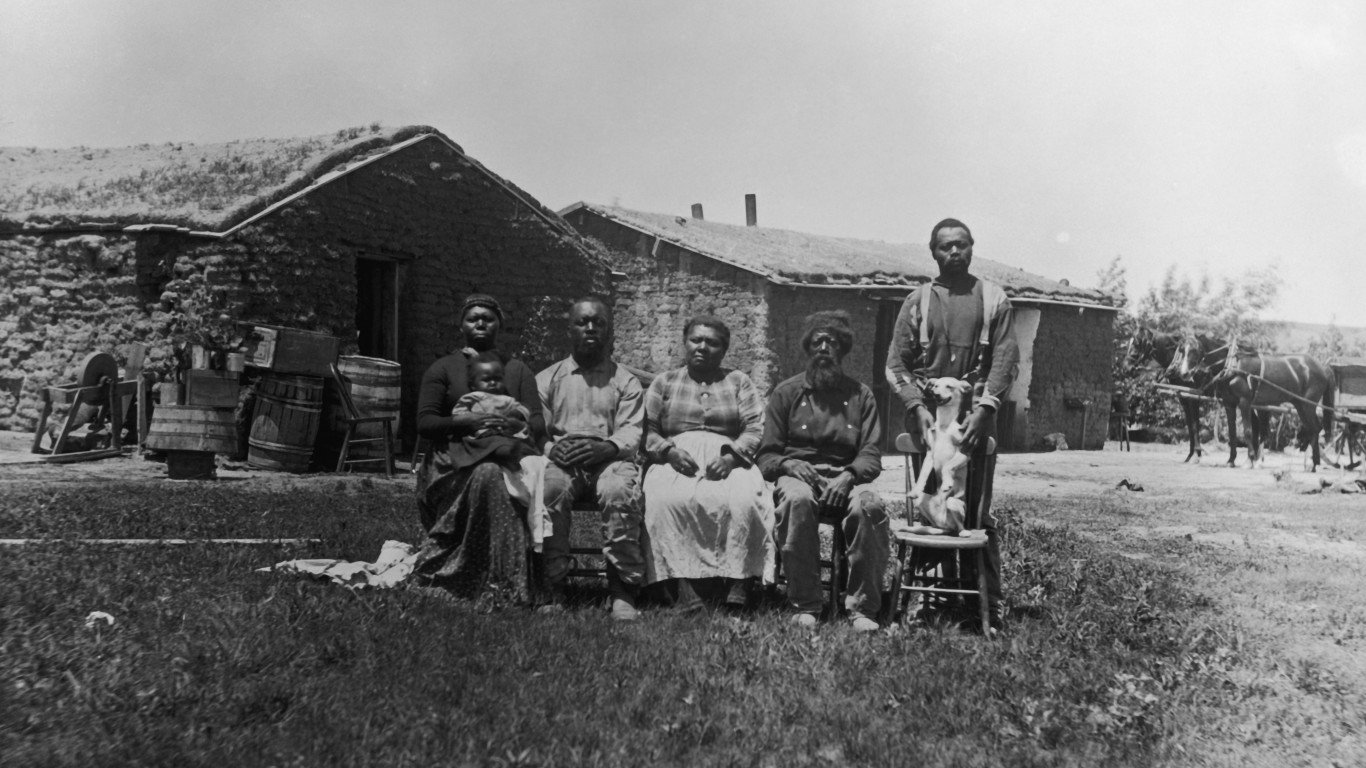
Photographer Solomon D. Butcher captures yet another portrait of homesteading families, this time showcasing the family of Jerry Shores in front of their home near Westerville, in Custer Country, Nebraska. Shores was one of several former slaves who homesteaded in the county and his property abutted those of his brothers, Moses Speese and Henry Webb. Each had different last names, taken from their different owners.
1889: A dilapidated homestead shack outside Guthrie, Oklahoma
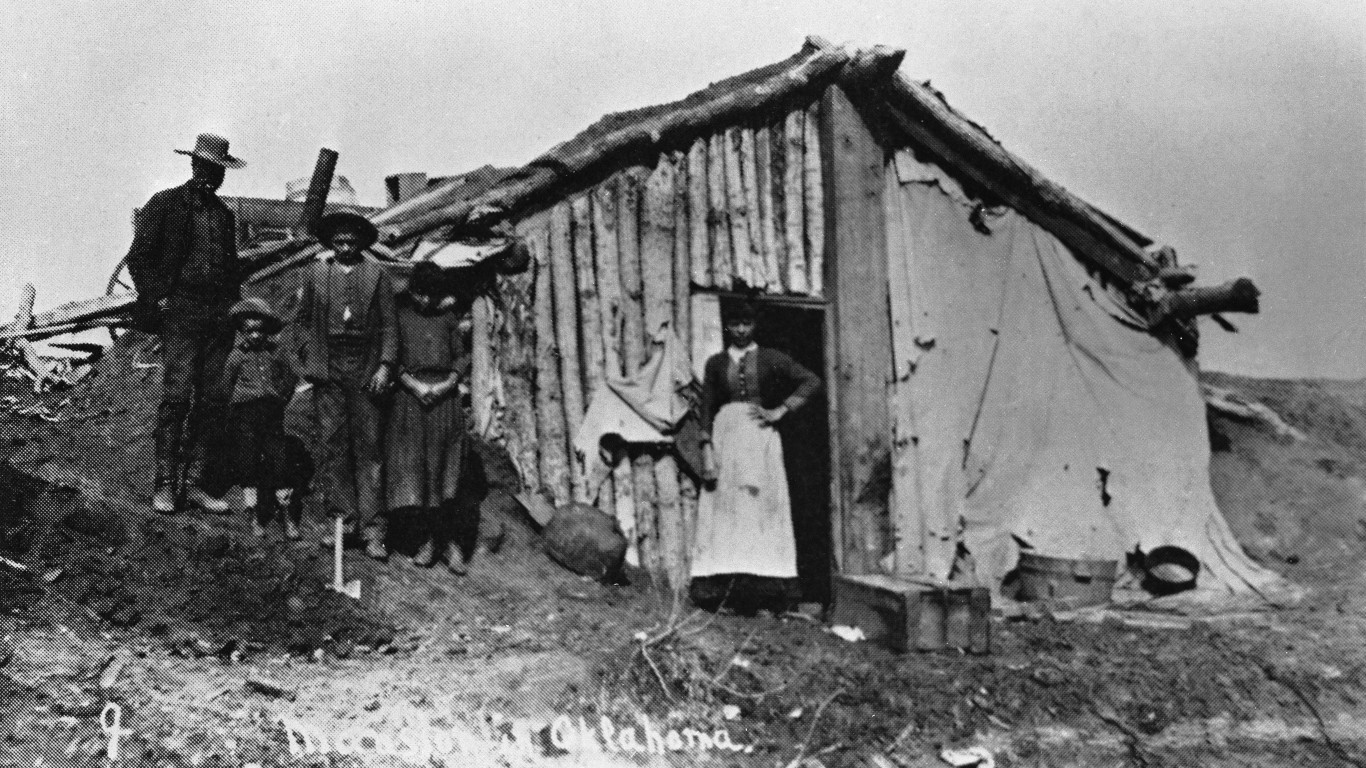
The Unassigned Lands area was a region that was ceded to the United States by the Creek and Seminole Indians following the Civil War. None of these lands were assigned to any Indian tribe (they had been removed from the area). This area of Oklahoma Territory was opened to the Land Rush of 1889, a free-for-all homesteading event at which about 50,000 people lined up to race into the region to claim lots of up to 160 acres each.
Photographer Harmon T. Swearingen came to Guthrie after the land rush and opened a photography studio, capturing many images of the town as it grew, and took this picture of homesteaders who took up residence in this shack outside Guthrie to certify their claim.
1890: Grounds of the Pullman factory in Chicago

Pullman was a model industrial town, built by engineer and industrialist George Pullman who founded the Pullman Car Company in 1862 to manufacture railroad sleeping cars. He had a 4,000-acre tract of land where he constructed a factory and “company town” called Pullman on the Southside of Chicago in the hopes of attracting the most skilled workers to build his railroad cards.
Housing accommodations for workers included indoor plumbing and gas for heating and cooking, luxuries for the working class at the time, and the complex included ornamental gardens and parks.
1890: A Tucson, Arizona home
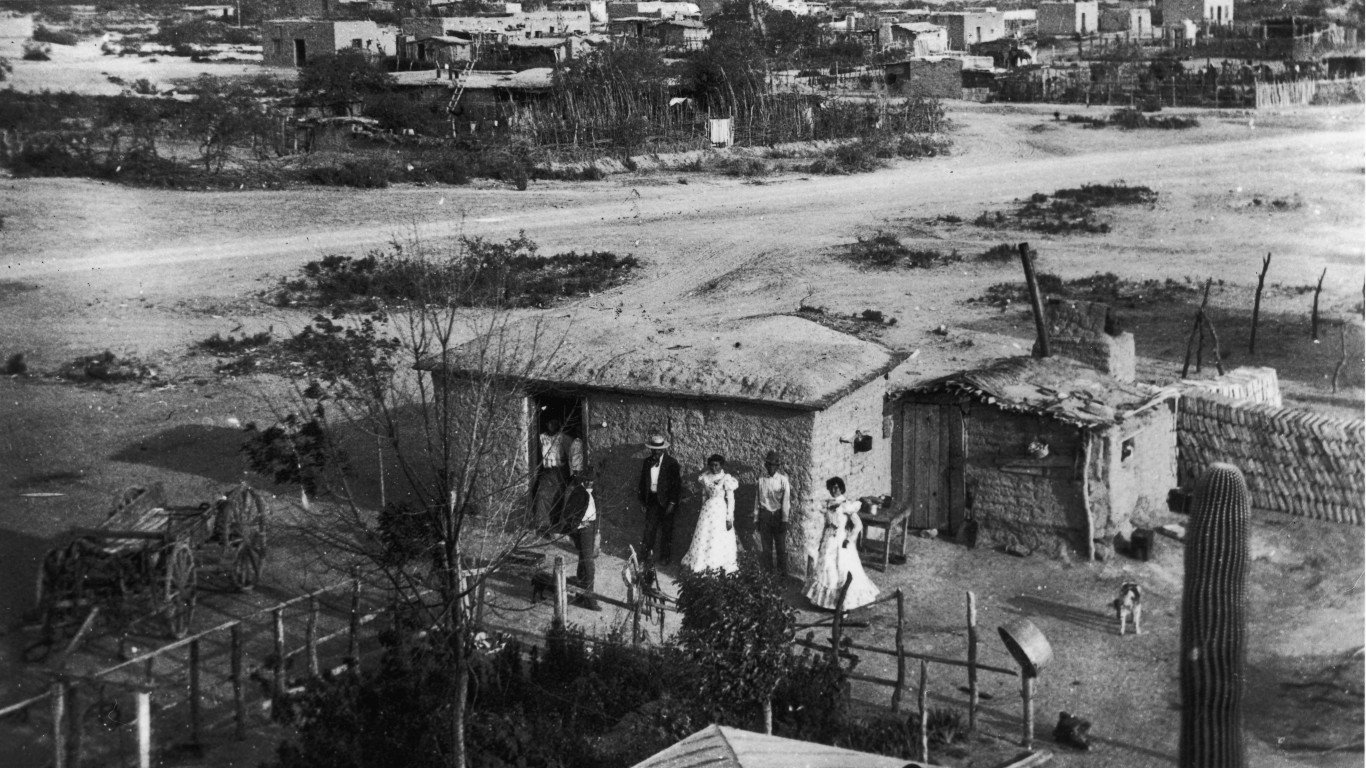
Not much information is known about this image and who the photographer was but it showcases seven people (and one dog) standing in front of their adobe brick home on the outskirts of town. The family is described as “A.S Jones and Mexican friends Tony Salas and Maria Rodriguez standing outside of their home.”
1890: The meeting of the Allegheny and Monongahela rivers
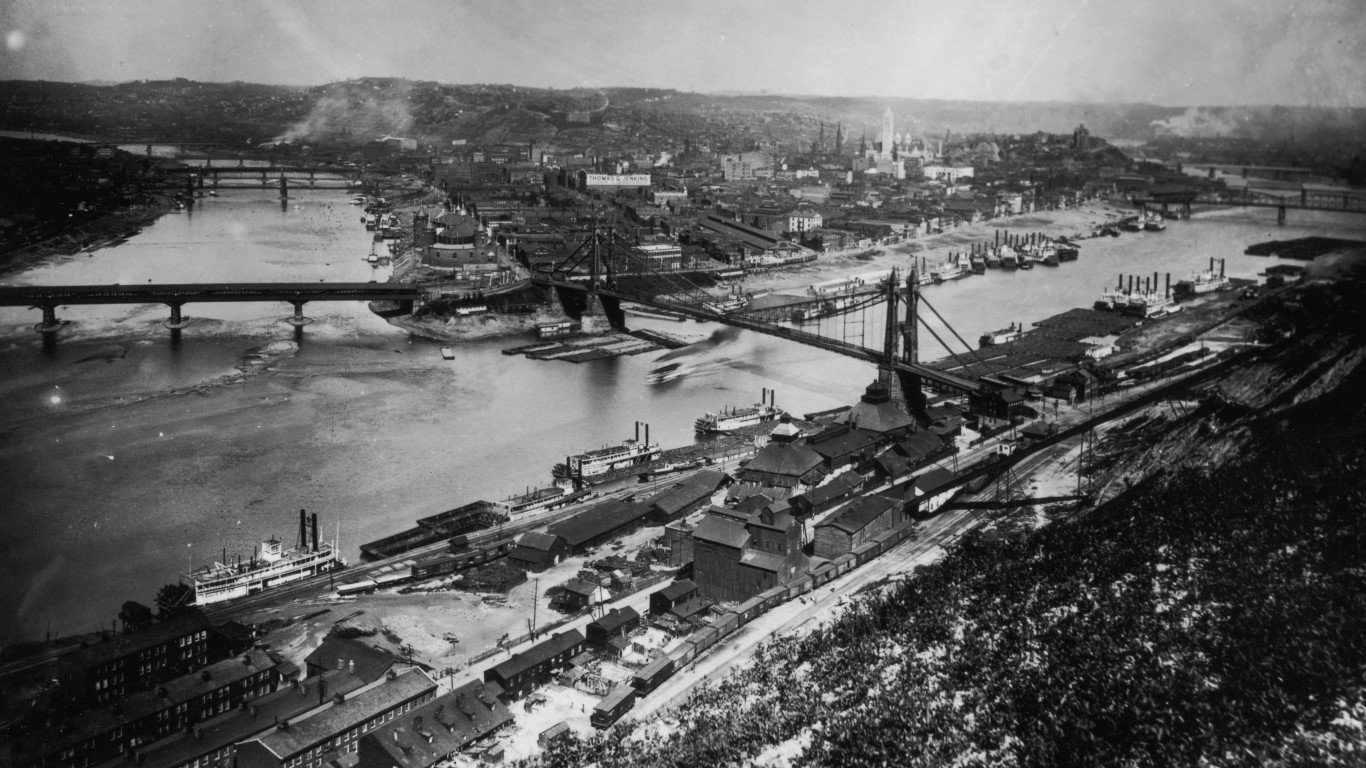
The 981-mile-long Ohio River flows through or along the border of six states before emptying into the Mississippi River in southern Illinois. This aerial view shows the point at which the Ohio forms, at the confluence of the Allegheny and Monongahela rivers, at what is now Point State Park in Pittsburgh.
1892: Immigrants exchanging money on Ellis Island, New York
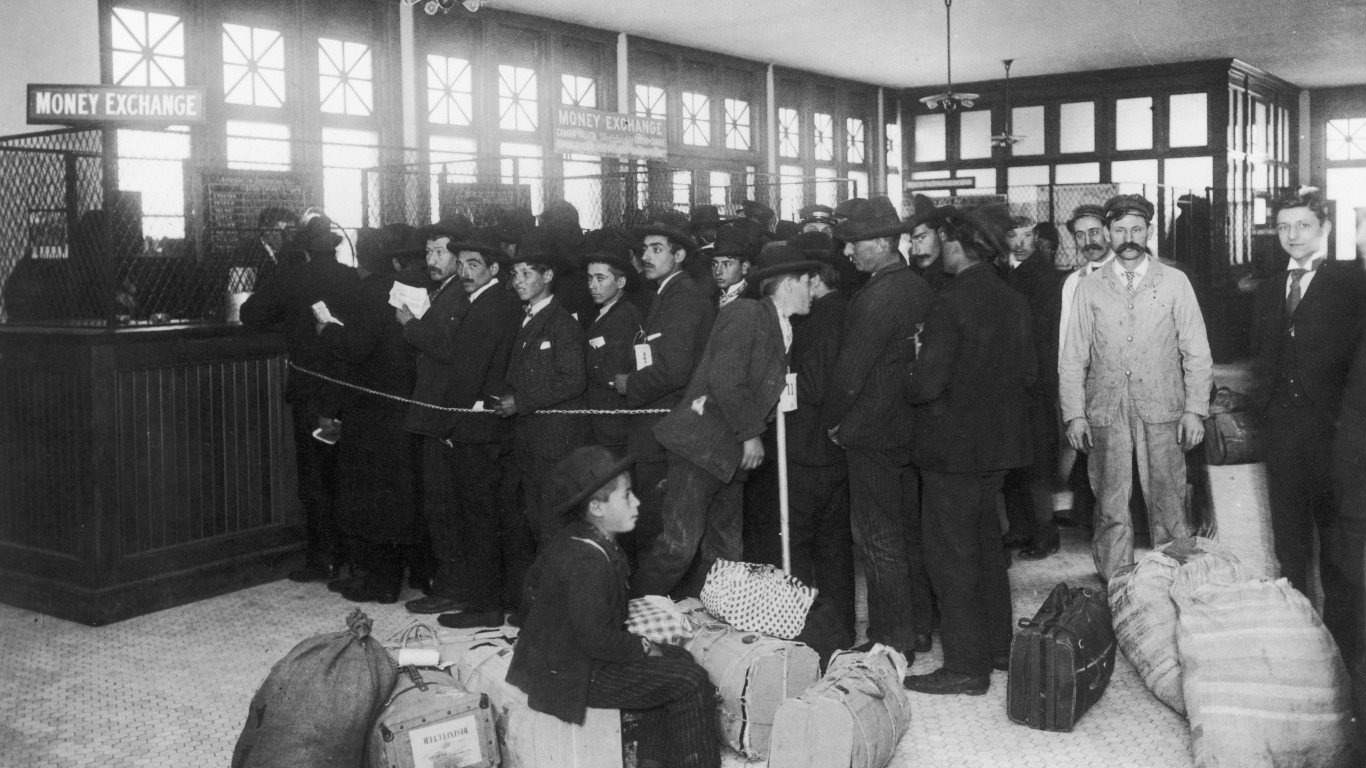
The first immigration station in New York was established at Castle Clinton, also known as Castle Garden, at the southern end of Manhattan and predates Ellis Island (it served as an immigration landing depot from 1855 to 1890). Construction of a new facility began on Ellis Island, off the coast of New Jersey, in 1890.
The U.S. government opened the Ellis Island Immigration Station on Jan. 1, 1892. Once an immigrant had been admitted to the country, the next stop was this Money Exchange, where foreign currencies, gold, and silver could be converted into American dollars.
1892: School children saluting the American flag
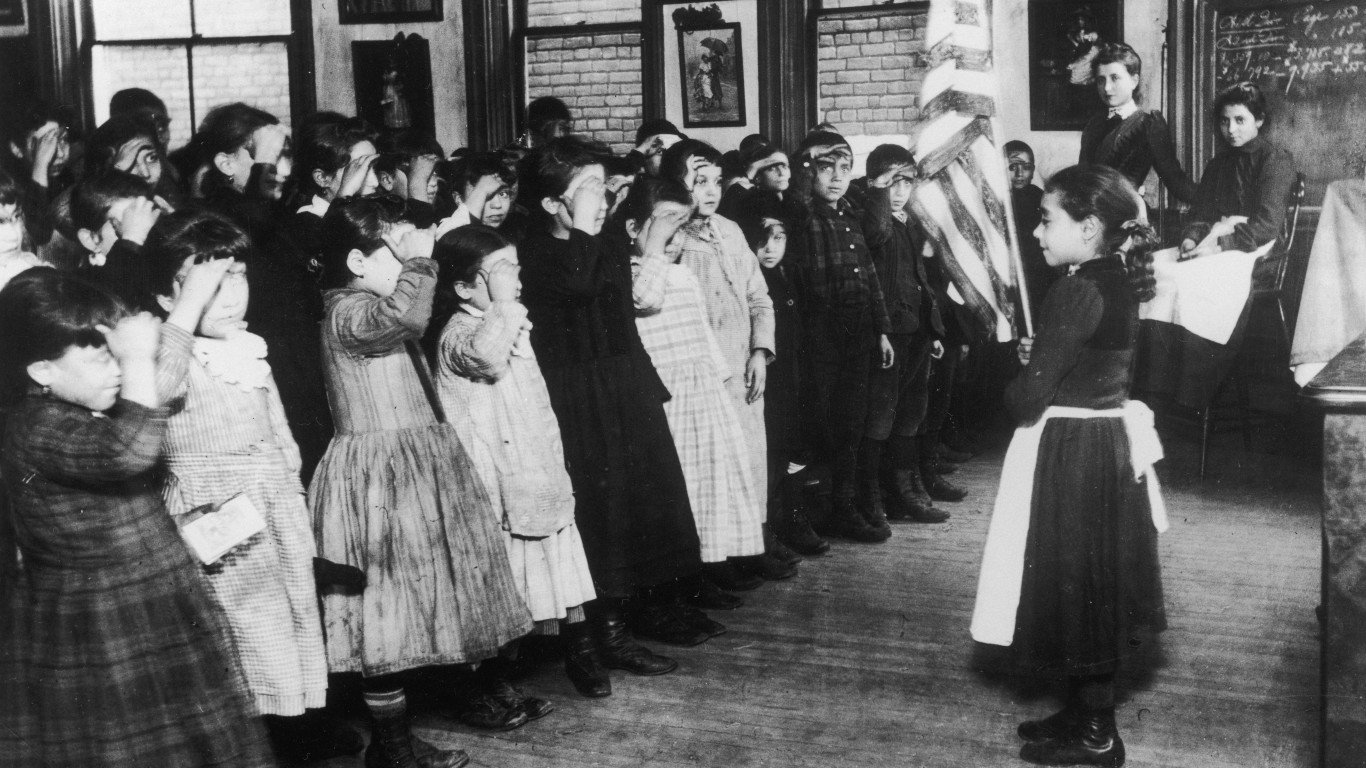
Jacon Riis was not only a social activist but the Danish-American journalist was also a serious photographer. His portfolio included many images of New York tenement life and other scenes. He shot this image of young school children saluting the American flag at the Fourteenth Ward Industrial School on Mott Street, in the Manhattan neighborhood now called Nolita. The school was sponsored by millionaire John Jacob Astor III.
1892: Boys woodworking class, New York City

There isn’t much information on this image of schoolboys studying woodworking in a manual training class at an unnamed school in New York City but it might have been taken by famed social documentary photographer Jacob Riis who shed light on poverty in New York City.
The manual training movement, which grew popular in the 1870s, wasn’t geared towards any particular trade but was based on the idea that teaching the skills associated with wood- and metalworking would improve not only hand-eye coordination but also powers of observation and judgment among students.
1893: A horse race in the Cherokee Outlet, Oklahoma

On Sept. 16, 1893, the Cherokee Outlet Opening took place in Oklahoma. It was the fourth and biggest land run, a race by would-be homesteaders to claim land, in the state. This photo was taken about ten seconds after the starting gun set off the race. According to the Oklahoma Historical Society, “Economic pressures plus poor planning and inadequate enforcement by federal agencies made it even more chaotic than earlier runs, resulting in massive fraud, widespread suffering, and several deaths.”
1895: Timber loading in Tacoma, Washington
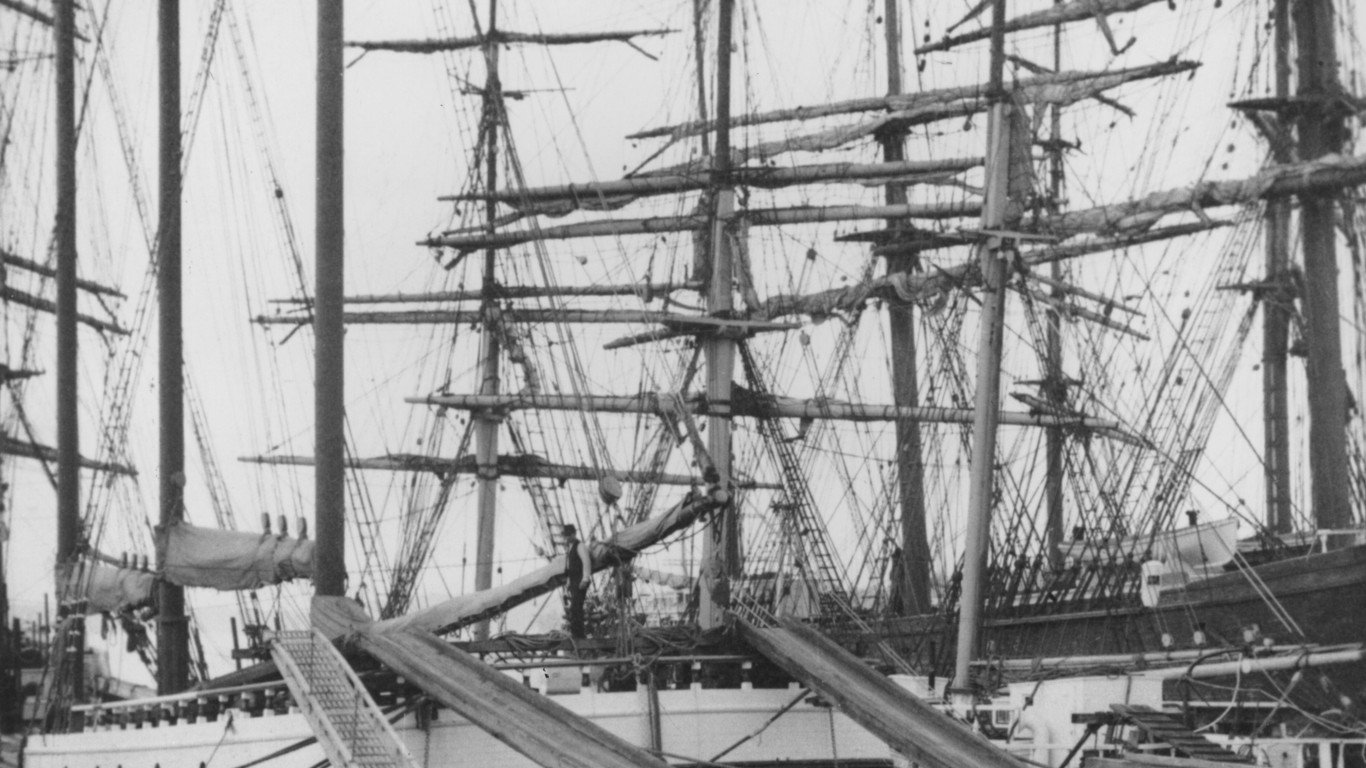
Due to the California Gold Rush, which began in January 1848, there was a huge demand for lumber in San Fransisco and nearby mining towns as a result of the building boom. Most of the supplies were provided by lumber mills around Puget Sound in Washington.
After 1871, one local sawmill began exporting to Peru by ship, creating an international market for Pacific Northwestern lumber developed. The lumber in this photo is probably bound for an international destination, as most of the wood sold domestically at the time was transported by rail.
1896: A hansom cab in Union Square, New York City
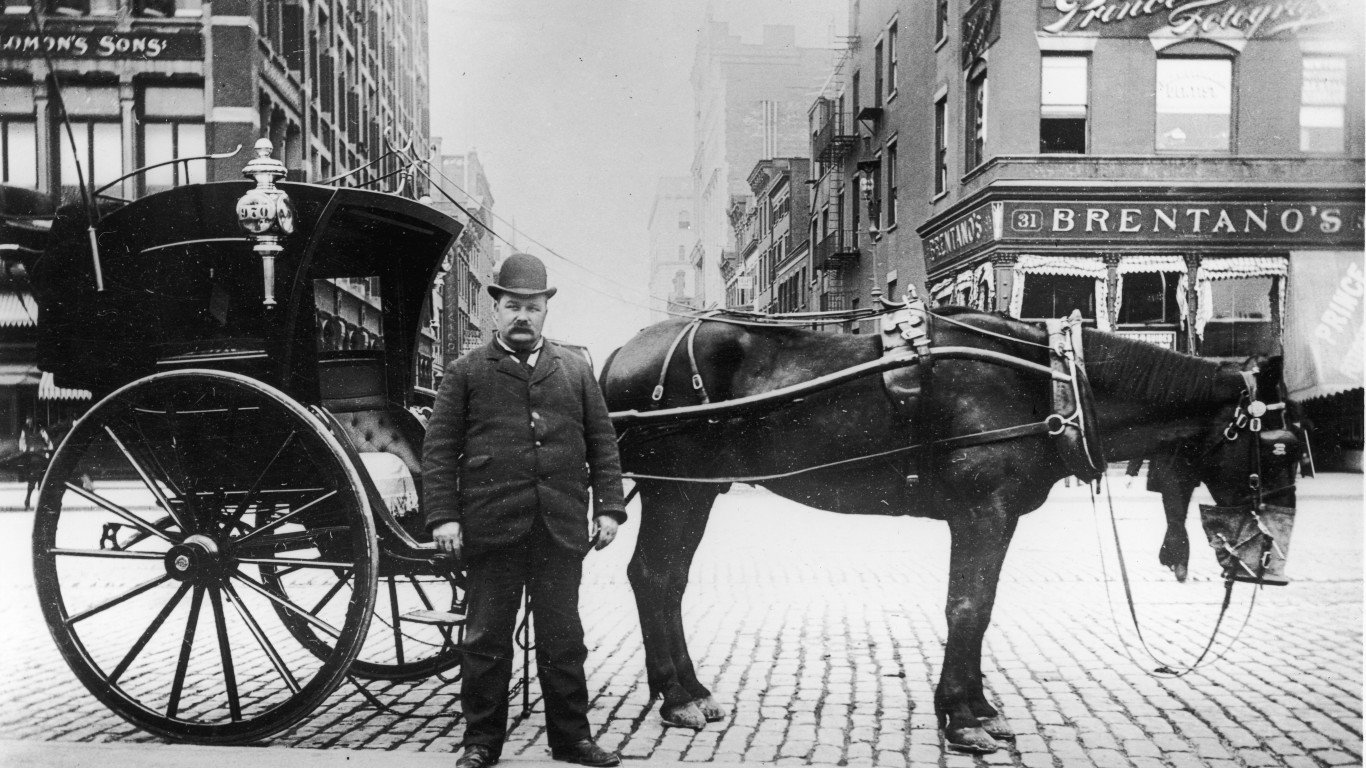
The Hansom cab, patented in 1834, had an unusual design that placed the driver in an elevated box behind the passenger compartment. This image of a Hansom and its driver waiting for customers on Union Square in Manhattan was taken by Alice Austen, a noted photographer who first picked up a camera at the age of 10. She spent most of her professional career documenting life on Staten Island, where she lived.
1897: Italian immigrants, Jersey Street, New York City
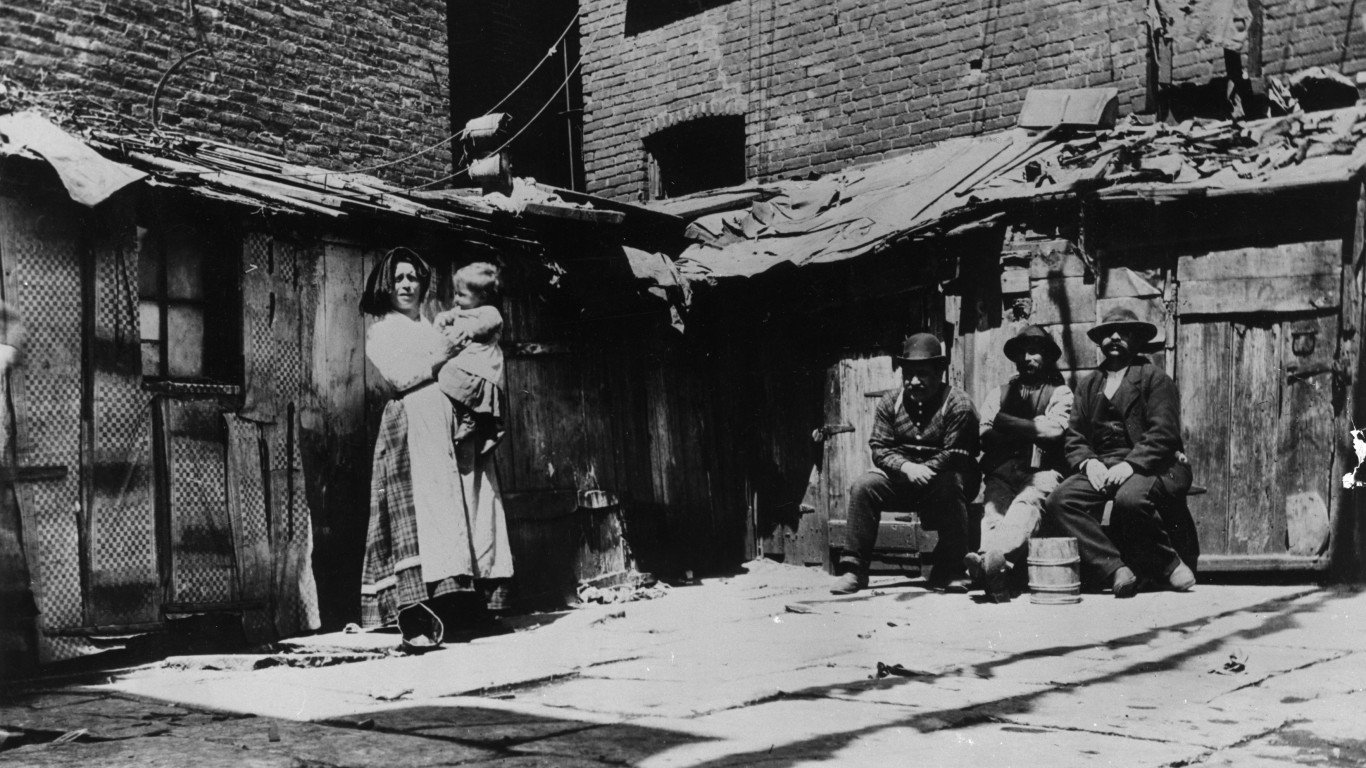
Renowned social documentary photographer Jacob Riis, a Danish-American journalist, took many images of immigrant and tenement life in New York City in the late 19th and early 20th centuries. This is a group portrait of a family of Italian newcomers to America who lived in a shack on Jersey Street in the neighborhood now known as SoHo.
1898: Chinatown, San Francisco
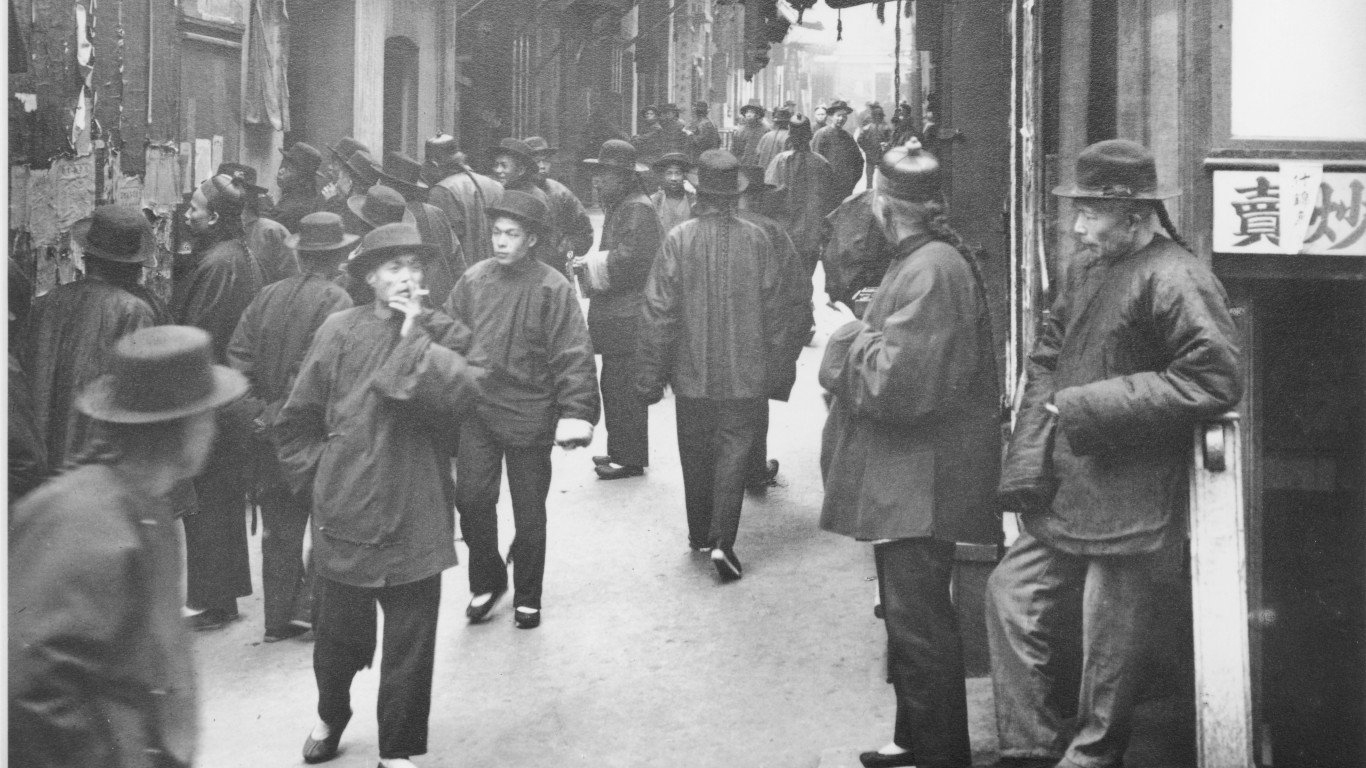
The German-American photographer Arnold Genthe shot this picture on Ross Alley, Chinatown’s so-called “street of gamblers.” He was famous for his photographs of San Francisco, especially of Chinatown and of the aftermath of the 1906 earthquake that devastated the city. Ross Alley runs parallel to Stockton Street and Grant Avenue. This street was built in 1849 and soon became known for its brothels and gambling dens.
